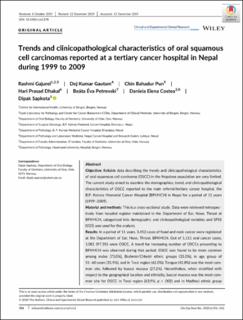| dc.description.abstract | Objective
Reliable data describing the trends and clinicopathological characteristics of oral squamous cell carcinoma (OSCC) in the Nepalese population are very limited. The current study aimed to examine the demographics, trend, and clinicopathological characteristics of OSCC reported to the main referral/tertiary cancer hospital, the B.P. Koirala Memorial Cancer Hospital (BPKMCH) in Nepal for a period of 11 years (1999–2009).
Material and methods
This is a cross‐sectional study. Data were retrieved retrospectively from hospital register maintained in the Department of Ear, Nose, Throat at BPKMCH, categorized into demographic and clinicopathological variables and SPSS (V25) was used for the analysis.
Results
In a period of 11 years, 3,452 cases of head and neck cancer were registered at the Department of Ear, Nose, Throat, BPKMCH. Out of 1,111 oral cancer cases, 1,081 (97.3%) were OSCC. A trend for increasing number of OSCCs presenting to BPKMCH was observed during that period. OSCC was found to be more common among males (73.0%), Brahmin/Chhetri ethnic groups (33.0%), in age group of 51–60 years (31.9%), and in Terai region (62.0%). Tongue (42.8%) was the most common site, followed by buccal mucosa (27.2%). Nevertheless, when stratified with respect to the geographical location and ethnicity, buccal mucosa was the most common site for OSCC in Terai region (63.9%, p = .002) and in Madhesi ethnic group (34.2%, p < .001). Majority of OSCC cases were diagnosed at advanced stage (49.7%, Stage IV) and received a combination therapy (42.0%).
Conclusions
Hospital‐based records can provide valuable information on disease characteristics in countries like Nepal. This study revealed that the clinicopathological characteristics of OSCC in Nepal follow the global trend. Nevertheless, relationship between specific intraoral sites for OSCC with geographic location and ethnic groups is an interesting observation and requires further population‐based studies to clarify these findings. | en_US |

